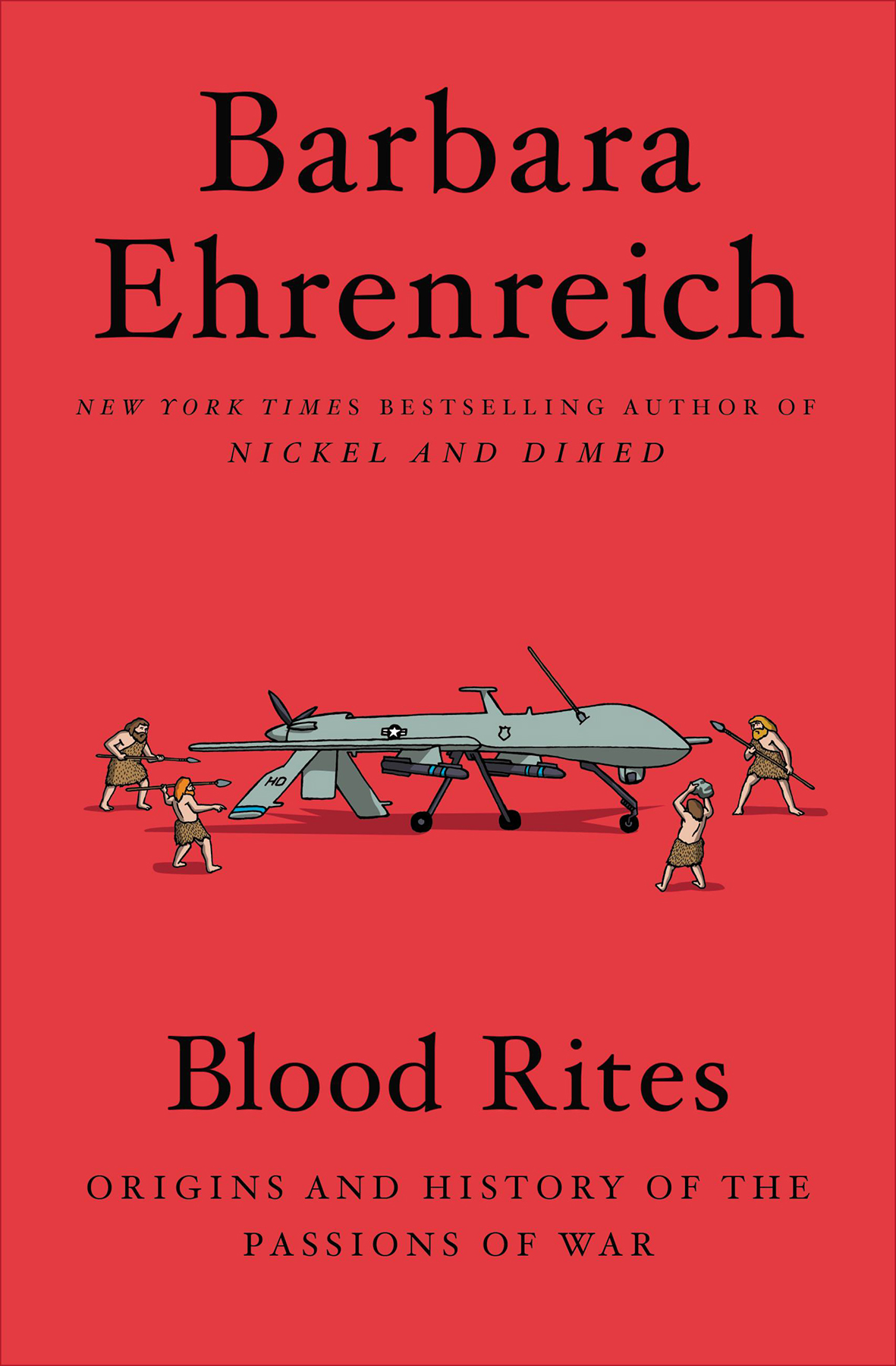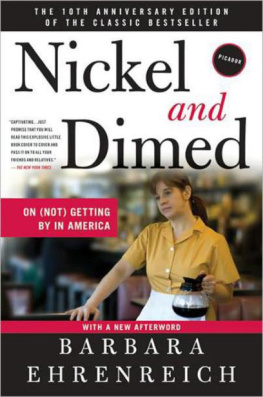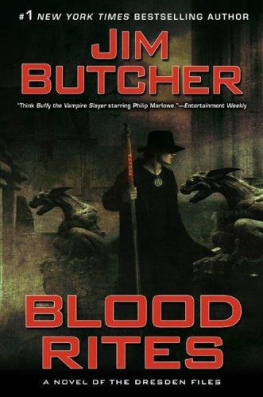Barbara Ehrenreich - Blood Rites
Here you can read online Barbara Ehrenreich - Blood Rites full text of the book (entire story) in english for free. Download pdf and epub, get meaning, cover and reviews about this ebook. year: 2020, publisher: Grand Central Publishing, genre: History. Description of the work, (preface) as well as reviews are available. Best literature library LitArk.com created for fans of good reading and offers a wide selection of genres:
Romance novel
Science fiction
Adventure
Detective
Science
History
Home and family
Prose
Art
Politics
Computer
Non-fiction
Religion
Business
Children
Humor
Choose a favorite category and find really read worthwhile books. Enjoy immersion in the world of imagination, feel the emotions of the characters or learn something new for yourself, make an fascinating discovery.
- Book:Blood Rites
- Author:
- Publisher:Grand Central Publishing
- Genre:
- Year:2020
- Rating:3 / 5
- Favourites:Add to favourites
- Your mark:
- 60
- 1
- 2
- 3
- 4
- 5
Blood Rites: summary, description and annotation
We offer to read an annotation, description, summary or preface (depends on what the author of the book "Blood Rites" wrote himself). If you haven't found the necessary information about the book — write in the comments, we will try to find it.
Blood Rites — read online for free the complete book (whole text) full work
Below is the text of the book, divided by pages. System saving the place of the last page read, allows you to conveniently read the book "Blood Rites" online for free, without having to search again every time where you left off. Put a bookmark, and you can go to the page where you finished reading at any time.
Font size:
Interval:
Bookmark:

Copyright 1997 by Barbara Ehrenreich
Introduction copyright 2020 by Mark Danner
Cover design and illustration by Jarrod Taylor
Cover copyright 2020 by Hachette Book Group, Inc.
Hachette Book Group supports the right to free expression and the value of copyright. The purpose of copyright is to encourage writers and artists to produce the creative works that enrich our culture.
The scanning, uploading, and distribution of this book without permission is a theft of the authors intellectual property. If you would like permission to use material from the book (other than for review purposes), please contact permissions@hbgusa.com. Thank you for your support of the authors rights.
Twelve
Hachette Book Group
1290 Avenue of the Americas, New York, NY 10104
twelvebooks.com
twitter.com/twelvebooks
Originally published in hardcover in 1997 by Metropolitan Books.
First Twelve Edition: January 2020
Twelve is an imprint of Grand Central Publishing. The Twelve name and logo are trademarks of Hachette Book Group, Inc.
The publisher is not responsible for websites (or their content) that are not owned by the publisher.
The Hachette Speakers Bureau provides a wide range of authors for speaking events. To find out more, go to www.hachettespeakersbureau.com or call
(866) 376-6591.
LCCN: 2019904651
ISBNs: 978-1-4555-4370-0 (trade paperback), 978-1-4555-4371-7 (ebook)
E3-20191119-PDJ-PC-REV
Explore book giveaways, sneak peeks, deals, and more.

S ome years ago I had occasion to need a theory of war. The occasion, fortunately, was only a literary one: I had been asked to write the preface to the English translation of a book about the twentieth-century German warrior elite, Klaus Theweleits fascinating Male Fantasies. I was flattered to be asked, but felt inadequate to the task. After all, my only qualification was that I had written a book about men and masculinity (The Hearts of Men), and nothing in that had touched on the subject of war.
I soon found that there are no theories of war ordepending on what you are willing to accept as a theoryfar too many of them. Ask a scholar for an explanation of war, and he or she will most likely snicker at your navet in expecting that something so large and poorly defined could even be explained. Ask a nonspecialist, however, and you will get any of a dozen explanations, each proffered with utter confidence: It is because of our innate aggressiveness or because of innate male aggressiveness or because of imperialism and greed or overpopulation and a shortage of resources or manipulation by evil, bloody-minded elites or it is simply a manifestation of unknowable evil.
Our understanding of war, it occurred to me, is about as confused and unformed as theories of disease were roughly 200 years ago. At that time there was no consensus among men of science as to whether disease arose from sources within the afflicted individual, such as ill humours and bad habits, or whether its source lay in something outside usin the night air, for example, or dangerous miasmas. Among the public at large, sinwhich played the same role in early theories of disease as innate aggressiveness plays in those of warremained a popular explanation. None of this would be cleared up until the middle of the nineteenth century, when the discovery of a heretofore invisible and unsuspected agent of diseasegermswould open the way to seeing all diseases as biological afflictions, traceable to molecular and cellular events, though of course embedded in the social ecology of cities and classes and migrations and conquests.
In one way, our prospects of understanding war are far bleaker than the prospects of understanding disease were two centuries ago. At least at that time, the period of Enlightenment in Western thought, educated people were convinced that a theory was discoverable and well worth the effort of seeking. Today there is no such self-confidence among the people most entitled to possess it. The social scientists to whom one might naturally turn for some understanding of an institution like war have, in all too many cases, given up on big questions and sweeping theories of any sort and are engaged instead in narrow empirical studies or, what is safer yet, critiques of studies already done.
But the silence of the academics can only frustrate the curious layperson. There is something in us, or at least something in some of us, that urgently seeks to make sense out of disconnected data and unassimilated experience, to draw links between people like us and people not at all like us, between what happened long ago and what is happening right now or could happen next. The urgency increases when the subject at hand, like war or disease, involves life and death, including the potential death of all people on earth. We need to know, and we need to know something more than piles of unrelated observations.
So the reckless amateur rushes in where the prudent scholar fears to tread. Eleven years ago, prodded by the assignment of a two-thousand-word preface to a book unknown in my own country, I began my study of war. Unrestrained by loyalty to any particular academic discipline, I read widely and at first almost randomly, puzzling over ethnographic and historical detail, savoring the sweeping perspectives of those few who dared to propose them. Being a journalist as well as an amateur scholar, I not only read peoples books and articles but also tracked down the authors at their homes or offices and pestered them with my questions. I shamelessly borrowed from my childrens higher educations, studying over their shoulders, as it were, anthropology at Oxford and religious studies at Brown. I gave talks which were initially mostly questions, and left with new insights and long lists of suggested readings.
In keeping with my original preoccupations, as well as with Theweleits theme, my suspicions first centered on the theme of gender. Wars, after all, have been fought, in almost all cases, by men, and sometimes for the stated purpose of making them men. But as I pressed back further in time and broadened my inquiry to include other forms of organized and socially sanctioned violencesuch as rituals of blood sacrificea deeper and far more ancient explanatory theme emerged. This was not something I had ever thought about before; in fact, it lay entirely outside my conceptual framework and analytic approach to the world. What it amounts to is a new evolutionary perspective on war and related forms of violence, butif I am right about the direction in which the relevant scholarship is tendingone that will not remain new and startling for long.
This is a theory about the feelings people invest in war and often express as their motivations for fightingwhere these feelings might have originated and how they have played out in history. I should emphasize at the outset that human feelings do not account for all that we might want to know about war or particular warswhy they start, in each instance, or end in the ways that they do. On the question of what causes war or any particular war, Tolstoy still has the last word:
The deeper we delve in search of these causes the more of them we discover, and each single cause or series of causes appears to us equally valid in itself, and equally false by its insignificance compared to the magnitude of the event.
Font size:
Interval:
Bookmark:
Similar books «Blood Rites»
Look at similar books to Blood Rites. We have selected literature similar in name and meaning in the hope of providing readers with more options to find new, interesting, not yet read works.
Discussion, reviews of the book Blood Rites and just readers' own opinions. Leave your comments, write what you think about the work, its meaning or the main characters. Specify what exactly you liked and what you didn't like, and why you think so.













